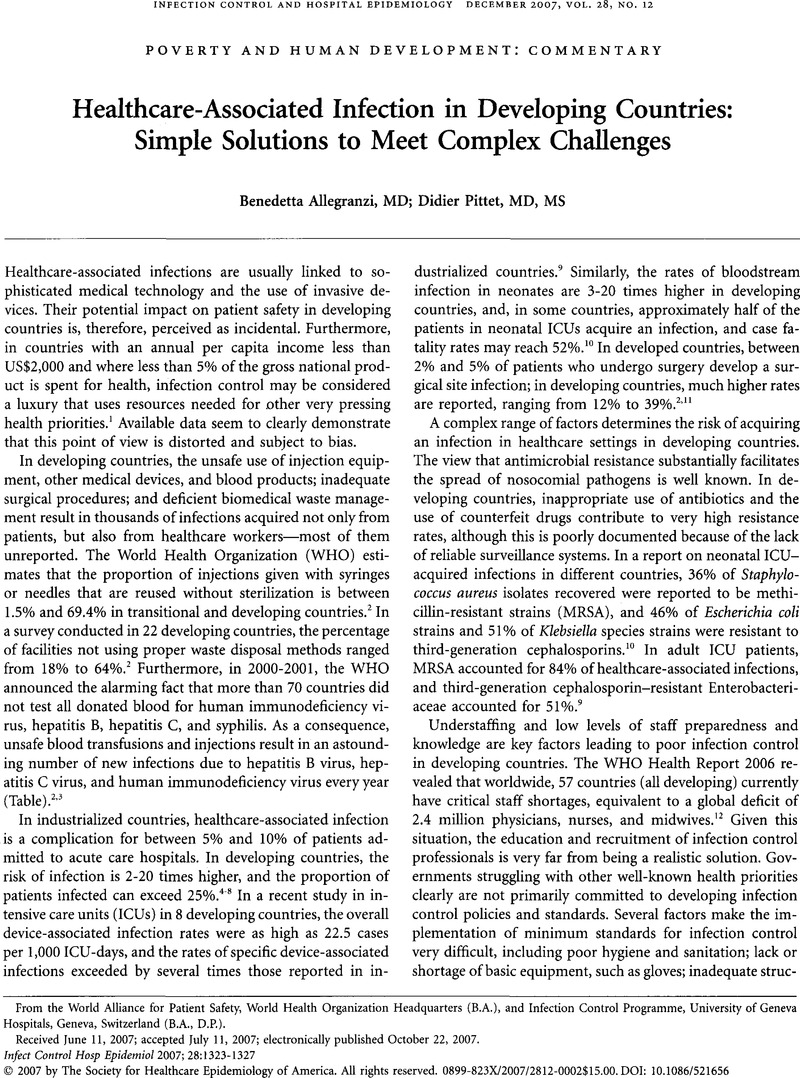Crossref Citations
This article has been cited by the following publications. This list is generated based on data provided by Crossref.
Malani, Preeti N.
2007.
Addressing Poverty and Human Development—Synonymous With Infection Control.
Infection Control & Hospital Epidemiology,
Vol. 28,
Issue. 12,
p.
1321.
Nguyen, Kim V.
Nguyen, Phuong Tran My
and
Jones, Stephanie L.
2008.
Effectiveness of an alcohol‐based hand hygiene programme in reducing nosocomial infections in the Urology Ward of Binh Dan Hospital, Vietnam.
Tropical Medicine & International Health,
Vol. 13,
Issue. 10,
p.
1297.
Storr, J.
and
Pittet, D.
2008.
Letter to the Editor.
American Journal of Infection Control,
Vol. 36,
Issue. 7,
p.
499.
Bellissimo-Rodrigues, Fernando
Silva, Magda Fabbri Isaac
Souza, Regina Puti de
and
Castro, Paulo de Tarso de Oliveira e
2008.
Alcohol-Based Hand Rub and Nosocomial Scabies.
Infection Control & Hospital Epidemiology,
Vol. 29,
Issue. 8,
p.
782.
Allegranzi, Benedetta
and
Pittet, Didier
2008.
Preventing infections acquired during health-care delivery.
The Lancet,
Vol. 372,
Issue. 9651,
p.
1719.
DiazGranados, Carlos A.
Cardo, Denise M.
and
McGowan, John E.
2008.
Antimicrobial resistance: international control strategies, with a focus on limited-resource settings.
International Journal of Antimicrobial Agents,
Vol. 32,
Issue. 1,
p.
1.
Pittet, Didier
and
Allegranzi, Benedetta
2008.
A unified approach to infection control: hand hygiene as the entrance door.
Healthcare infection,
Vol. 13,
Issue. 2,
p.
25.
Apisarnthanarak, A.
and
Fraser, V. J.
2009.
Feasibility and Efficacy of Infection-Control Interventions to Reduce the Number of Nosocomial Infections and Drug-Resistant Microorganisms in Developing Countries: What Else Do We Need?.
Clinical Infectious Diseases,
Vol. 48,
Issue. 1,
p.
22.
Macharashvili, Nino
Kourbatova, Ekaterina
Butsashvili, Maia
Tsertsvadze, Tengiz
McNutt, Louise-Anne
and
Leonard, Michael K.
2009.
Etiology of neonatal blood stream infections in Tbilisi, Republic of Georgia.
International Journal of Infectious Diseases,
Vol. 13,
Issue. 4,
p.
499.
Younus, Muhammad
Siddiqi, Azfar-E-Alam
and
Akhtar, Saeed
2009.
Reassessment of Selected Healthcare Associated Risk Factors for HBV and HCV Infections among Volunteer Blood Donors, Karachi, Pakistan.
Central European Journal of Public Health,
Vol. 17,
Issue. 1,
p.
31.
Allegranzi, B.
and
Pittet, D.
2009.
Role of hand hygiene in healthcare-associated infection prevention.
Journal of Hospital Infection,
Vol. 73,
Issue. 4,
p.
305.
Krämer, Alexander
and
Hossain Khan, Md. Mobarak
2009.
Modern Infectious Disease Epidemiology.
p.
23.
Braun, Barbara I.
Kusek, Linda
and
Larson, Elaine
2009.
Measuring adherence to hand hygiene guidelines: A field survey for examples of effective practices.
American Journal of Infection Control,
Vol. 37,
Issue. 4,
p.
282.
Saint, Sanjay
Bartoloni, Alessandro
Virgili, Gianni
Mannelli, Francesco
Fumagalli, Stefano
di Martino, Paolo
Conti, Andrea A.
Kaufman, Samuel R.
Gensini, Gian Franco
and
Conti, Antonio
2009.
Marked variability in adherence to hand hygiene: A 5-unit observational study in Tuscany.
American Journal of Infection Control,
Vol. 37,
Issue. 4,
p.
306.
Apisarnthanarak, Anucha
and
Fraser, Victoria J.
2009.
Feasibility and Efficacy of Infection‐Control Interventions to Reduce the Number of Nosocomial Infections and Drug‐Resistant Microorganisms in Developing Countries: What Else Do We Need?.
Clinical Infectious Diseases,
Vol. 48,
Issue. 1,
p.
22.
Longtin, Yves
Sax, Hugo
Leape, Lucian L.
Sheridan, Susan E.
Donaldson, Liam
and
Pittet, Didier
2010.
Patient Participation: Current Knowledge and Applicability to Patient Safety.
Mayo Clinic Proceedings,
Vol. 85,
Issue. 1,
p.
53.
Allegranzi, Benedetta
Sax, Hugo
Bengaly, Loséni
Riebet, Hervé
Minta, Daouda K.
Chraiti, Marie-Noelle
Sokona, Fatoumata Maiga
Gayet-Ageron, Angele
Bonnabry, Pascal
and
Pittet, Didier
2010.
Successful Implementation of the World Health Organization Hand Hygiene Improvement Strategy in a Referral Hospital in Mali, Africa.
Infection Control & Hospital Epidemiology,
Vol. 31,
Issue. 2,
p.
133.
Owusu-Ofori, Alex
Jennings, Rebecca
Burgess, Jennifer
Prasad, Priya A.
Acheampong, Faustina
and
Coffin, Susan E.
2010.
Assessing Hand Hygiene Resources and Practices at a Large African Teaching Hospital.
Infection Control & Hospital Epidemiology,
Vol. 31,
Issue. 8,
p.
802.
Bédat, B.
Mauler, F.
Allegranzi, B.
Chraïti, M.-N.
Touveneau, S.
Babloyan, A.
Pósfay-Barbe, K.M.
and
Pittet, D.
2010.
Successful hand hygiene improvement strategy in a referral children’s hospital in Armenia.
Journal of Hospital Infection,
Vol. 76,
Issue. 4,
p.
362.
Labeau, Sonia O.
Witdouck, Stijn S.
Vandijck, Dominique M.
Claes, Brigitte
Rello, Jordi
Vandewoude, Koenraad H.
Lizy, Christelle M.
Vogelaers, Dirk P.
and
Blot, Stijn I.
2010.
Nurses' Knowledge of Evidence-Based Guidelines for the Prevention of Surgical Site Infection.
Worldviews on Evidence-Based Nursing,
Vol. 7,
Issue. 1,
p.
16.





